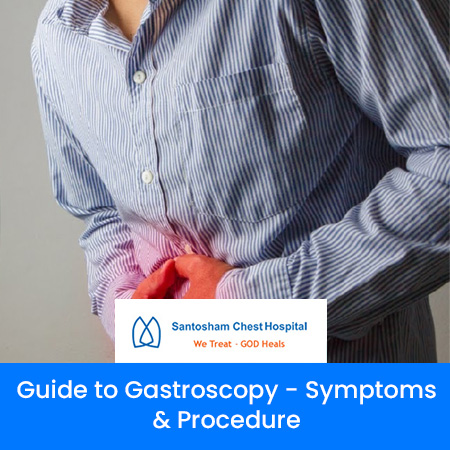Guide to Gastroscopy - Symptoms & Procedure
April 30, 2019
Gastroscopy is a process in which the oesophagus is examined with the help of a sophisticated, thin tube called an endoscope. This process is administered to those suffering from gastrointestinal problems.

Procedure:
For proper examination of the GI tract, you are advised not to eat anything before 8 hours of endoscopy. Before the process, the patient is administered a sedative to keep them relaxed. The sedative is given through an intravenous injection. Then you are given a liquid to gargle and throw multiple times, in order to numb our buccal cavity and to prevent chocking. The staff will try to keep you as calm as possible. The tube is inserted in the mouth of the patient and it is inserted down from the food pipe to the stomach and ends up at the small intestine. The doctors administered through the screen and delivers report accordingly. This process is also called upper gastrointestinal endoscopy.
During the upper GI endoscopy, the doctor may
- Take small samples of tissue, cells, or fluid in your upper GI tract for testing.
- Stop any type of internal bleeding.
- Open up closed veins and dilation.
Doctors also use upper GI endoscopy to perform the following tasks:
- Treat internal bleeding from ulcers, esophageal varices or other conditions
- Dilate or open up strictures with a small balloon passed through the endoscope
- Remove those objects that remain stuck in the GI tract.
- Remove polyps and other abnormal growths
- Serves as feeding and drainage tubes
Symptoms showing the need of Gastroscopy:
- Pain in the stomach
- Indigestion of food
- Heartburn
- Dysphasia- pain while swallowing food
- Anemia- low RBC count in the blood that may lead to internal bleeding
- Tar like stool
- Blood oozing with vomiting
- Sudden, sharp abdominal pain
- Regular heartburn
- Persistent internal bleeding
- Nausea and vomiting along with blood
- Pain in stomach
- Problems while swallowing food
- Unexplained weight loss
Types of Gastroscopy:
- Stomach ulcers - the lining of the stomach and the intestine gets affected. Internal bleeding is common.
- Gastro-intestinal reflux disease- also called GORD. In this condition the stomach acid refluxes into the gullet causing burning sensations.
- Barret’s oesophagus- the food pipe witnesses several abnormal cells on them.
- Portal Hypertension- an acute condition where the blood pressure of the stomach remains excessively high leading to puffed veins on the lining of the stomach and food pipe.
- Coeliac disease- an abnormal indigestion problem where the person is unable to digest the swallowed food. Eating food becomes a painful affair in this condition.
- Stomach cancer or oesophageal cancer.
- Gastroesophageal reflux disease
- Inflammation, or swelling of internal organs
- Precancerous abnormalities of internal organs
- Strictures or narrowing of the food pipe
- Blockages
The entire process will take you 15 to 30 minutes altogether. The process do not cause breathing problems and you may fall asleep during the process. It also helps in addressing problems where a person consumes toxic chemicals or fluids. Doctors have used this technique to address people suffering from acute obesity problems.
RECENT BLOGS
- Post-Heart Surgery Care: Essential Tips for Faster Recovery and Better Heart Health
- Physiotherapy in Healthcare: Why It’s Essential for Post-Operative Recovery
- A Complete Guide to Ultrasonography: Procedure, Benefits, and Applicationss
- The Complete Guide to Pulmonary Function Tests: Preparing, Procedure, and Results
- Breathing Easy: Simple Habits for Better Lung Health and Wellness
- Understanding Asthma: Symptoms, Triggers, and How to Manage It Effectively
- Recognizing a Heart Attack: Early Symptoms and Immediate Steps to Take
- CT Scans: Everything You Need to Know – Procedure, Precautions, and How They Help Your Health
- Choosing the Right Hospital: What Patients Need to Know for Better Healthcare
- The Journey to Better Digestive Health: Identifying Issues with Gastroscopy
- Simple Food Habits to Boost Your Immune System and Respiratory Health
- The Importance of Regular Health Screenings for Heart Disease Prevention
- Fit for Life: The Health Benefits of Regular Exercise for Everyone
- Living with Pulmonary Hypertension: Managing Symptoms and Improving Quality of Life
- Exploring the Lifelong Benefits of Physical Activity on Heart Health
- The Role of CT Scans in Diagnosing Respiratory Conditions: What Patients Need to Know
- Unlocking the Benefits of Regular Physical Activity for Heart Health
- The Role of Diet in Asthma Management: Foods to Eat and Avoid
- The Role of CT Scans in Diagnosing Respiratory Disorders
- How to Prepare for Thoracic Surgery: A Patient’s Guide
- BreatheWell Insights: Navigating Respiratory Health with Santosham Chest Hospital
- Gastroscopy Demystified: Your Essential Guide to Digestive Health
- Thoracic back pain treatment
- Quit smoking save your lungs – how to quit smoking?
- Asthma Symptoms and Treatments You Should Know
- Best Chest Hospital in India
- Exercises for COPD patients
- What To Expect At A Pulmonary Function Test
- Types of Asthma Medications
- Tips for keeping your lungs healthy
- Santosham Hospital- the best Pulmonology Hospital in India
- Guide to Gastroscopy - Symptoms & Procedure
- COPD - Know the Signs and Symptoms & Get the Facts
- Living with Pulmonary Hypertension
- Smoking and COPD Effects
- What You Need To Know About Asthma
- Side effects of eating too much choclate
- Top 4 Ways You Can Purify Your Lungs Naturally
- Rotational shifts are disrupting your metabolism
- How to survive heart attack when you’re alone?
- Tips for a Healthy Mind, Body And Spirit
- Seven Ways to Cut the Junk Food
- How Fruits and Vegetables are important for the diet?
- 5 reasons why walk is the best workout
- 7 benefits of eating healthy and exercising regularly
- 7 Best Exercise To Keep Your Heart Healthy Forever
- 10 Good Habits for Healthy Heart
- 10 Foods to Keep your Heart Healthy

